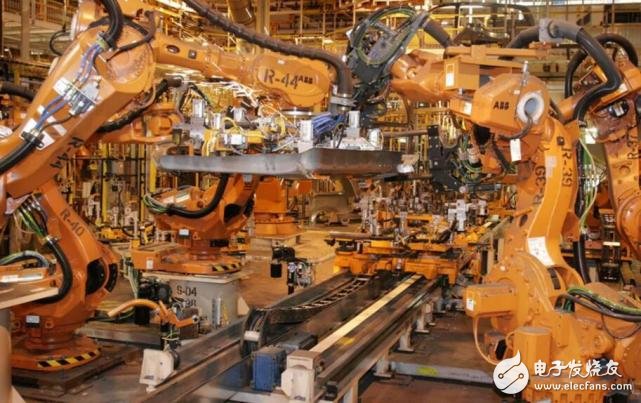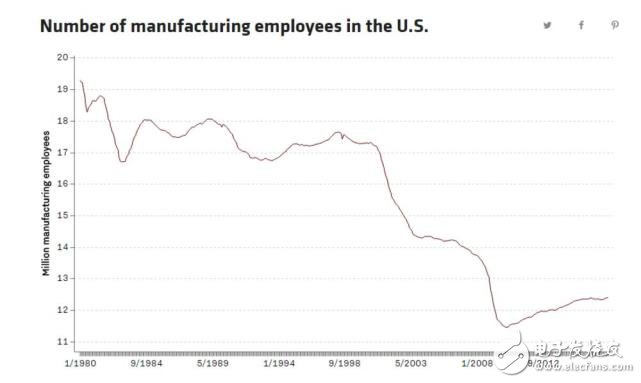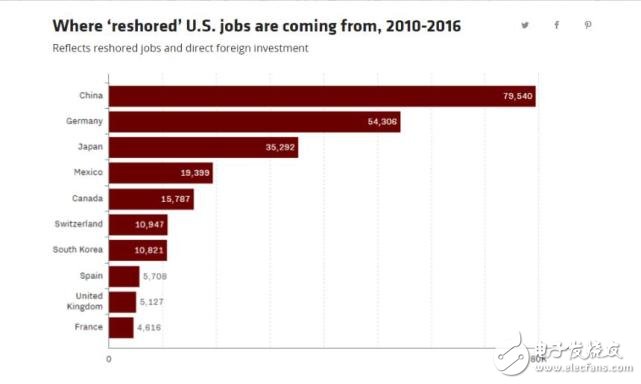Electronic enthusiasts eight o'clock in the morning: In the long run, many people believe that automation and robotics will replace a large number of manufacturing jobs. This is of course possible, but for now, although the number of robots in company plants in North America is increasing, the number of human jobs in manufacturing is also increasing.

According to data released by the US Bureau of Labor Statistics, as of April 2017, the number of manufacturing workers in the United States reached 12.4 million. This is a net increase of 25,000 over last year and an increase of nearly 1 million from the beginning of 2010. However, compared with 1980, the manufacturing industry still reduced by one third, and more than 6 million people lost their jobs.

Changes in the number of manufacturing workers in the United States from 1980 to 2012
Reshoring IniTIaTIve, a company that is committed to bringing jobs back to the United States, shows that 2016 is the first time in more than a few years that manufacturing jobs have returned to the United States. In 2016, the number of manufacturing jobs in the US increased by 25,000. During this period, more than 50,000 jobs left the United States, while 77,000 jobs were returned, or non-US companies invested in the United States.
According to the report, from 2010 to 2016, most of the manufacturing jobs that returned to the United States originated from China. Reshoring IniTIaTIve founder Harry Moser said that China's labor costs are getting higher and higher. In the past 15 years, the percentage of Chinese workers' wages has increased from 12% to 15%.

US manufacturing job reversal from 2010 to 2016
The automotive industry accounts for the majority of returning jobs in the United States, followed by electronic components and electrical appliances manufacturing. According to the report, these industries are focused on producing such products: offshore, outsourcing, does not provide them with significant overall cost-saving benefits, both in terms of size and weight.
However, it remains to be seen how much more and more automation is being used in this reflow trend. According to the Robotic Industries Association, robots purchased by North American companies in the first quarter of 2017 increased by 32% compared to the same period last year. The reason for growth is mainly because robots are getting cheaper and cheaper.
Even though human and robotic work in manufacturing is increasing, the machine may eventually take more human work. The National Bureau of Economic Research published a report in early 2017 and found that between 1990 and 2007, every time a robot was introduced to a factory, six people were eliminated. So with the increase in robot sales, why is the number of jobs in the US manufacturing industry not plummeting? The answer now may be that robots help to return more work from overseas than to work that causes them to disappear.
For example, Trump claims to help persuade Carrier, a manufacturer in the United States, to decide to stay in the US, in part because of the need to save labor costs through automation. Adidas also said that its new plant in Georgia will be highly automated, with only 160 human workers. Therefore, although these factories remain in the United States, they do not employ large numbers of human workers as they have in the past.
Moser said: "If you have a factory that can assemble 500 cars a day, you shut it down 20 years ago and outsource production. Now you re-move the factory back to the US and assemble the same number of cars, maybe only It takes one and a half hands. The question is how long this human and robot benefit can last before the robot takes over all the work.
Disclaimer: The electronic reprinted works of E-Commerce Network are as far as possible to indicate the source, and all rights of the owner of the work are not transferred due to the reprint of this site. If the author does not agree to reprint, please inform the site to delete or correct it. Reprinted works may be subject to change in title or content.
I. Definition and overview
A high-frequency UPS is an Uninterruptible Power Supply (UPS) technology. It uses the high-frequency switching power supply technology to convert the input AC power into high-frequency AC power through the inverter and then converts the input AC power into stable direct current (DC) power for electronic devices. High frequency UPS plays an important role in modern power supply system because of its efficient conversion rate, small size design and fast response ability.
Two, the main characteristics
Efficient conversion rate:
High frequency UPS adopts a new IGBT (insulated gate bipolar transistor) inverter technology, and its conversion efficiency can reach more than 90%, which is much higher than the traditional low-frequency UPS, effectively reducing energy loss and improving the use efficiency. (Source: Shunqi network enterprise yellow pages and supply and demand information release platform)
Small volume design:
Because high-frequency UPS uses a more compact design, its volume is significantly smaller than low-frequency UPS, and its footprint is smaller, which is very suitable for use in space-limited environments, such as data centers and computer rooms. (source ibid.)
High power density:
The power density of high-frequency UPS is large, and it can provide greater power output in a small volume, improving the capacity and power supply efficiency of the equipment.
Quick response:
The high frequency UPS has a fast response capability and can provide stable power for the device immediately when the power supply of the grid is interrupted, ensuring that the continuous operation of the device is not affected.
Intelligent management:
Many high-frequency UPS are equipped with advanced intelligent management systems, which can monitor the status of power supply, battery status, load situation in real time, and have fault diagnosis, automatic switching, remote monitoring and other functions, improving the reliability and maintainability of the system.
High frequency Uninterrupted Power Supply,High frequency UPS system, High frequency online UPS
Foshan Keylewatt Technology Co., LTD , https://www.keylewatt.com